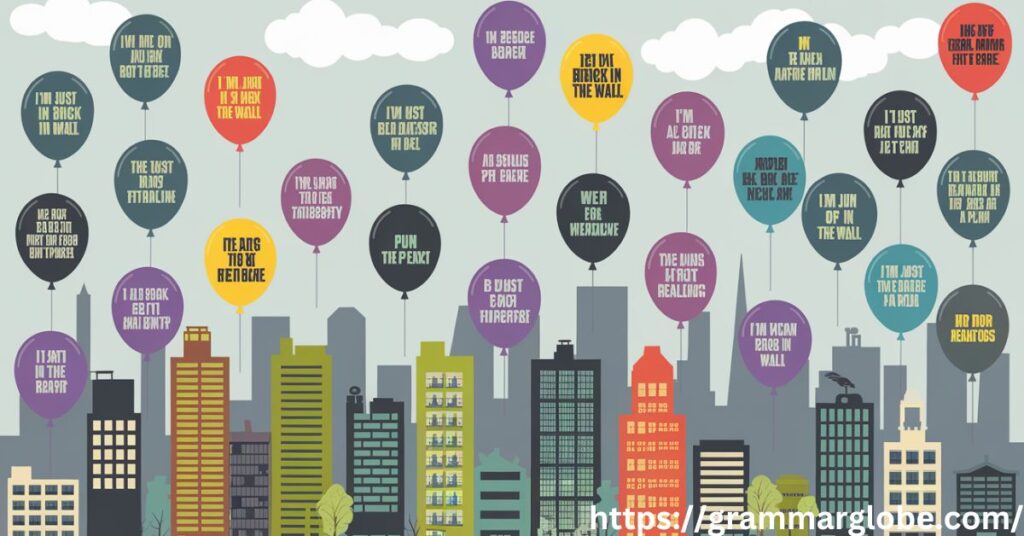Puns, those witty plays on words that make you chuckle (or groan), are more than just a casual form of humor. They showcase the depth and versatility of language, proving how a single word or phrase can carry layers of meaning. Whether in casual conversation or timeless literature, puns reveal the playful side of language mastery. Common Examples of Puns….
In this article, we’ll explore the definition of puns, dive into their types, examine 30 common examples of puns, and uncover their significance in literature. Along the way, we’ll highlight related literary devices and offer tips for recognizing puns in everyday life.
What is a Pun?
A pun is a form of wordplay that uses the multiple meanings of a word or the similarity in sound between different words to create humor or a witty effect. Often called “the lowest form of wit,” puns can be as subtle as a clever quip or as groan-worthy as a dad joke. At their core, puns rely on the audience’s understanding of language nuances to make sense of the double meanings or humorous twist.
There are several types of puns, including homophonic puns, which rely on words that sound alike but have different meanings (e.g., “time flies like an arrow; fruit flies like a banana”), and homographic puns, which use words with the same spelling but different meanings (e.g., “a bicycle can’t stand on its own because it’s two-tired”). Compound puns combine multiple layers of wordplay, while visual puns use imagery to enhance or replace linguistic wordplay.
Puns are more than just humor—they show mastery of language and creativity. They’re used in everyday conversation, literature, marketing, and even education to grab attention, entertain, or convey layered meanings. Whether in Shakespeare’s plays or your favorite meme, puns add color and wit to communication, making language a playful tool.
See also: 101+Hilarious Mosquito Puns And Jokes: Buzzing With Laughter
Why Do Common Examples of Puns Matter?
Puns are often dismissed as trivial jokes, but they serve a deeper purpose:
- They demonstrate language mastery. Understanding a pun requires recognizing nuances in phonetics, semantics, and context.
- They make language memorable. Wordplay leaves a lasting impression, whether in a Shakespearean play or a clever advertisement.
- They encourage creativity. Crafting or interpreting a pun challenges the brain, stimulating critical and lateral thinking.
Types of Common Examples of Puns
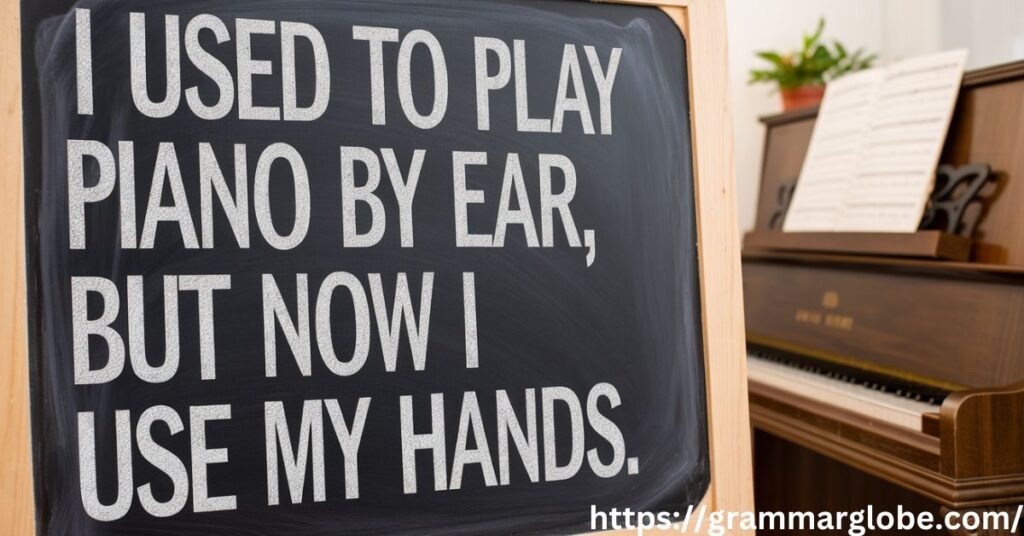
Puns come in various forms, each playing with language in a unique way. Let’s break down the types of puns and see how they work.
Homophonic Puns
Homophonic puns rely on words that sound alike but have different meanings or spellings.
- Example: “I’m on a seafood diet. I see food, and I eat it.”
- Explanation: “See food” and “seafood” sound identical, creating humor.
This type is common in spoken language because it plays with phonetics.
Homographic Puns
Homographic puns use words that are spelled the same but have different meanings, regardless of pronunciation.
- Example: “The ink was running low, so I decided to write in invisible ink instead.”
- Explanation: The word “ink” retains its spelling while its interpretation changes.
Homographic puns often work best in written contexts, where the spelling is evident.
Compound Puns
Compound puns combine multiple layers of wordplay in a single sentence.
- Example: “I couldn’t figure out how to fix the broken clock, so I just let time run out.”
- Explanation: The phrase combines the literal sense of a broken clock with the idiomatic meaning of letting time pass.
These puns often require a bit more thought to decode, making them particularly clever.
See also: 200 Hilarious Onion Puns That Will Make You Cry With Laughter
Visual Pun
Visual puns use imagery to convey humor, often combining pictures with clever captions or designs.
- Example: A picture of a loaf of bread with wings, captioned “breadwinner.”
- Explanation: The image plays on the literal and figurative meanings of “breadwinner.”
Visual puns are commonly used in marketing and memes because they catch the eye and make the message unforgettable.
30 Common Examples of Puns
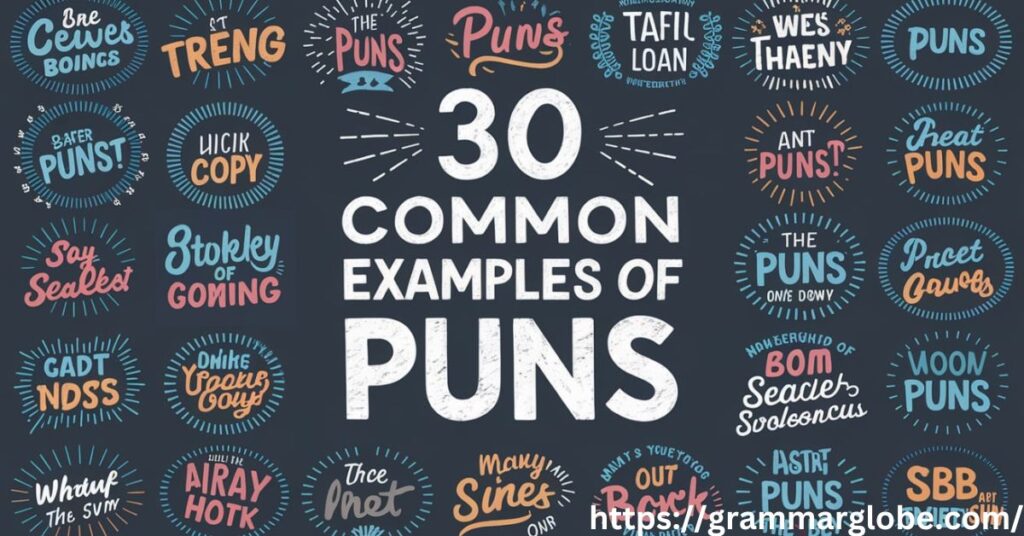
Puns add humor and wit to everyday conversation, literature, and media. Below are 30 examples of puns organized into different themes to showcase their versatility:
Food and Drink
- “I’m on a seafood diet. I see food, and I eat it.”
- “The baker stopped making dough because he couldn’t make enough bread.”
- “I relish the fact that mustard is part of every hotdog.”
- “The grape had to let out a little whine after being crushed.”
- “Don’t go bacon my heart. I couldn’t if I fried.”
Professions
- “The optometrist fell into his work because he made a spectacle of himself.”
- “The plumber’s jokes always drain the room of laughter.”
- “The carpenter nailed the joke but couldn’t screw it up.”
- “The teacher was so punny, she had the whole class groaning.”
- “The magician’s performance disappeared without a trace.”
Animals
- “The horse couldn’t run a race because he was feeling a little hoarse.”
- “The duck said to the bartender, ‘Put it on my bill.’”
- “The cow refused to give milk because it was udderly exhausted.”
- “The frog took the leap of faith—ribbit wasn’t easy!”
- “The bee apologized for buzzing into the wrong hive—it was un-bee-lievable.”
Nature and Science
- “I was reading a book about anti-gravity. It’s impossible to put down.”
- “Why did the tree take a nap? Because it was feeling rooted.”
- “The solar panel said, ‘I’m a big fan of renewable energy!’”
- “The geologist found their work ground-breaking.”
- “The mathematician thought the odds were against him, but he figured it out.”
You may like: 101+Hilarious Mosquito Puns And Jokes: Buzzing With Laughter
Entertainment and Pop Culture
- “The musician was in treble when he couldn’t find the right note.”
- “I told a joke about a broken pencil, but it was pointless.”
- “The actor found the script dramatic—it had too many plot twists.”
- “The comedian said, ‘I’m punstoppable!’ and the crowd groaned.”
- “The DJ loved vinyl records because they always had a spin on things.”
Everyday Life
- “The calendar’s days are numbered.”
- “I wanted a camouflage shirt, but I couldn’t find one.”
- “I stayed up all night wondering where the sun went, and then it dawned on me.”
- “The bicycle couldn’t stand on its own because it was two-tired.”
- “The scarecrow won an award because he was outstanding in his field.”
See also: 200 Hilarious Onion Puns That Will Make You Cry With Laughter
Why Common Examples of Puns Work
Each of these puns illustrates a clever use of language, often relying on:
- Double meanings: For example, “the calendar’s days are numbered” plays on the literal and figurative meanings of “numbered.”
- Homophonic wordplay: “Bacon my heart” sounds like “breaking my heart,” creating humor through sound.
- Clever associations: “The geologist’s work was ground-breaking” connects their profession to the literal act of breaking ground.
By combining humor, creativity, and language mastery, puns continue to entertain and inspire across all aspects of communication.
Common Examples Pun Themes
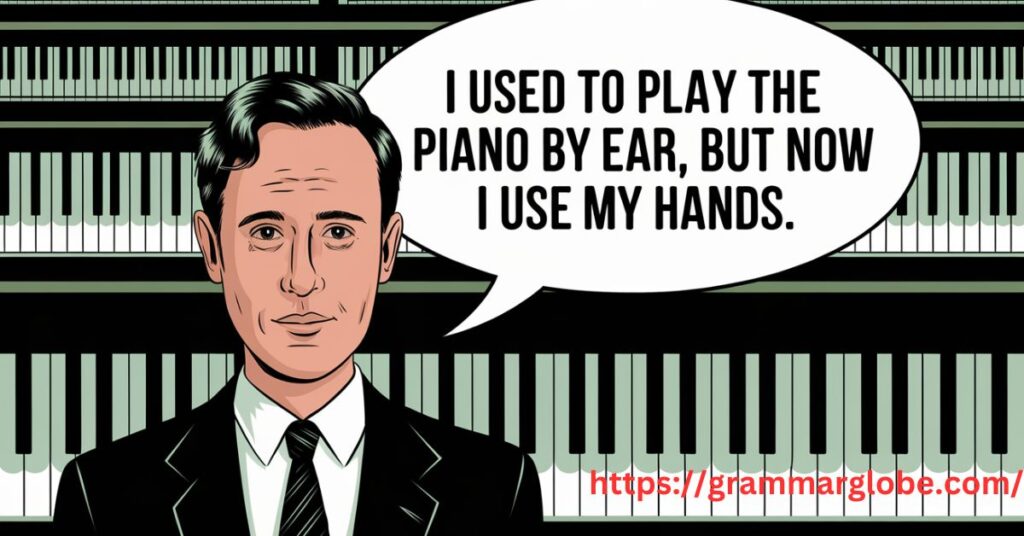
Puns aren’t just random jokes; they span across themes like professions, science, literature, and food. For instance:
- Food: “I relish the fact that mustard is part of a hotdog.”
- Science: “The physicist knew how to accelerate a conversation.”
- Professions: “The architect had plans for everything.”
Common Examples of Pun in Literature
Many great authors have used puns to enrich their works, adding humor, irony, or wordplay. Below are some iconic examples:
“Romeo and Juliet” by William Shakespeare
- Quote: “Ask for me tomorrow, and you shall find me a grave man.”
- Explanation: Mercutio uses “grave” to mean serious and literally dead, blending humor and tragedy.
See also: 150 Hilarious Hamster Puns And Jokes To Brighten Your Day
“Great Expectations” by Charles Dickens
- Quote: Pip is described as “brought up by hand.”
- Explanation: Dickens uses this phrase to humorously highlight Pip’s strict upbringing.
“Alice’s Adventures in Wonderland” by Lewis Carroll
- Quote: “We must try a little harder, or it will be out of sight before it disappears!”
- Explanation: Carroll’s whimsical narrative thrives on nonsensical yet clever wordplay.
“The Lorax” by Dr. Seuss
- Quote: “Unless someone like you cares a whole awful lot, nothing is going to get better. It’s not.”
- Explanation: Dr. Seuss uses rhyming and puns to convey a serious environmental message with a light tone.
Literary Devices Related to Common Examples of Pun
Puns overlap with several other literary techniques. Here’s a quick comparison:
| Device | Definition | Example |
|---|---|---|
| Double Entendre | Dual meanings, often humorous or risqué | “Marriage is a fine institution, but I’m not ready for an institution.” |
| Paronomasia | Wordplay using similar-sounding words | “A bicycle can’t stand on its own because it’s two-tired.” |
| Juxtaposition | Contrasting ideas placed side by side | “He was both a giant of a man and small-minded.” |
These tools, along with puns, enrich language by introducing layers of meaning and wit.
Fun Table: Comparing Types of Common Examples of Pun
| Type | Definition | Example |
|---|---|---|
| Homophonic | Words sound alike, different meanings | “I scream for ice cream.” |
| Homographic | Same spelling, different meanings | “The dove dove into the water.” |
| Compound | Combines multiple meanings | “I’m reading a book on anti-gravity.” |
| Visual | Relies on imagery for humor | A drawing of a clock with wings: “Time flies.” |
The Importance of Understanding Common Examples of Pun
Understanding puns is more than just recognizing a clever joke—it’s a window into the richness of language and communication. Puns demonstrate how words can carry multiple meanings, allowing for humor, depth, and creativity in both spoken and written contexts. They engage the brain by requiring the listener or reader to make connections between meanings, sounds, or images, enhancing cognitive flexibility and language mastery.
You may like: 260+ Funny Seagull Puns That Will Make You Laugh At The Beach
Puns also play a vital role in culture and expression. From Shakespearean plays to modern memes, puns highlight how humor and wit can transcend time and connect people. They’re used to break the ice in conversations, make complex ideas relatable in advertising, or add charm to storytelling. Their universal appeal ensures they remain a cherished tool for communication across languages and generations.
See also: Soaring High: 136+Eagle Puns To Make You Spread Your Wings
Moreover, puns sharpen critical thinking and linguistic skills, making them valuable in education and learning. Decoding a pun often involves understanding context, tone, and subtle language cues, which can strengthen comprehension and problem-solving abilities. By appreciating the artistry behind puns, we not only enhance our communication skills but also gain a deeper appreciation for the versatility and beauty of language.
Why Common Examples of Pun Are More Than Just Jokes
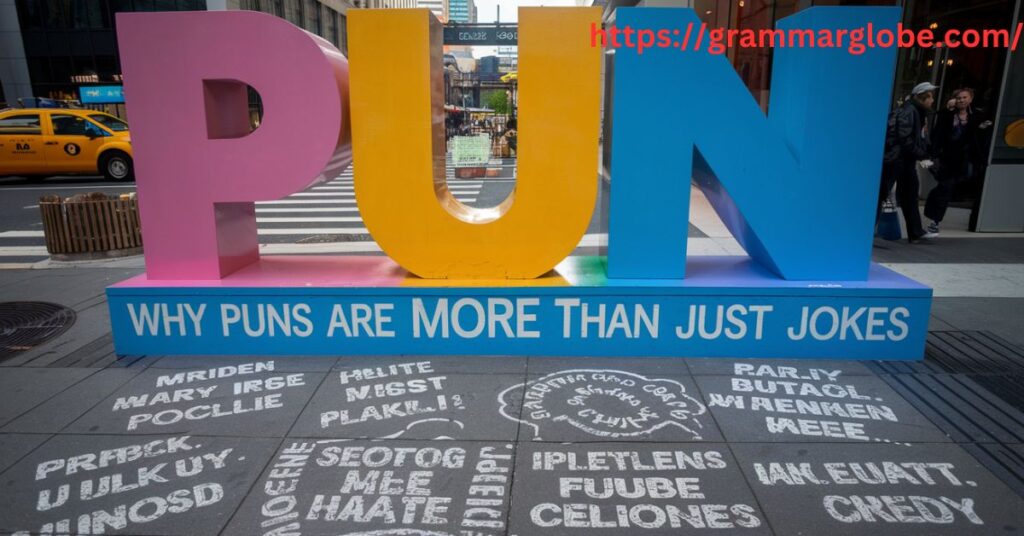
Puns are often dismissed as simple wordplay, but their value extends far beyond generating laughs. At their core, puns demonstrate the flexibility and creativity of language. They rely on double meanings, similar sounds, or clever associations to spark humor or provoke thought. This linguistic playfulness makes puns a powerful tool for effective communication, whether in literature, advertising, or everyday conversation.
In literature, puns add layers of meaning and depth. Shakespeare, for instance, used puns to showcase characters’ wit and underscore themes. Similarly, authors like Oscar Wilde and Lewis Carroll employed puns to entertain while subtly conveying complex ideas. In advertising, puns help brands stand out with slogans like “Let us ketchup with you,” making messages memorable and engaging.
You cam visit: 147+Hilarious Goose Puns That Will Make You Honk With Laughter
Beyond entertainment, puns enhance cognitive engagement by encouraging audiences to think critically about language. They require decoding of meanings, making them intellectually stimulating. Whether used to teach, amuse, or persuade, puns exemplify how humor and creativity can deepen understanding, leaving a lasting impact on the audience.
1. In Literature
Authors like Shakespeare, Lewis Carroll, and Oscar Wilde used puns to:
- Add humor to serious stories.
- Develop character wit and charm.
- Convey double meanings or hidden commentary.
For example, in The Importance of Being Earnest, Wilde’s entire play is a pun on the word “earnest” (sincere) and the name “Ernest,” which the main characters use deceptively.
2. In Advertising and Branding
Marketers use puns to make brands memorable and relatable:
- “Lettuce help you save!” – A grocery store slogan.
- “You’re in good hands.” – An insurance tagline.
These examples show how puns can simplify complex ideas and stick in consumers’ minds.
3. In Education
Teachers often use puns to engage students, particularly in language and literature classes. For instance:
- “The future, the present, and the past walked into a bar. Things got a little tense.”
This joke subtly reinforces grammar concepts while keeping students entertained.
See also: 200+ Hilarious Fly Puns That Will Make You Buzz With Laughter
How to Recognize and Enjoy Common Examples of Pun
Understanding puns can sometimes feel like solving a puzzle. Here are a few tips to improve your pun appreciation:
Listen for Sound-Alikes
If two words sound similar, consider their meanings in context. For instance:
- “Why do cows have hooves instead of feet? Because they lactose.”
Look for Double Meanings
Puns often hinge on ambiguous or multiple meanings of words. For example:
- “I couldn’t remember how to throw a boomerang, but eventually, it came back to me.”
You may like: 301+Delightful Butterfly Puns: Flutter With Laughter
Notice the Context
Puns often play off specific situations. For example, in a bakery, “Don’t loaf around too much!” works better than in a gym.
Enjoy the Groan
Part of the charm of common examples of puns is their ability to elicit groans along with laughter. Embrace the humor in their cheesiness.
Case Studies: Common Examples of Pun in Pop Culture
Puns are everywhere in modern media, from sitcoms to social media memes. Let’s examine a few standout examples:
Friends (TV Show)
- Episode Title: “The One with the Embryos”
- Pun: A play on words referencing both Phoebe’s surrogacy and the central storyline of the group’s embryo-like bond forming over a trivia game.
See also: 210 Hilarious Mermaid Puns And Jokes To Make A Splash
Meme
- A popular visual pun shows an image of a cat sitting on a photocopier with the caption: “Copycat.”
This example combines a literal visual element with a clever wordplay, making it both funny and memorable.
Marketing Campaigns
- The fast-food chain Wendy’s frequently uses puns in its social media posts:
- “We beef with other brands, but our burgers don’t.”
This pun plays on the double meaning of “beef,” showcasing wit while promoting their food.
Conclusion
Puns are much more than simple jokes—they represent the creative and playful potential of language. Whether they make us laugh, groan, or think, puns enrich communication by blending wit, humor, and cleverness. From Shakespeare’s timeless wordplay to everyday conversations, they highlight how versatile and fun language can be.
As the saying goes: “A good pun is its own reword.”
As we’ve seen common examples of puns i.e. appear in literature, advertising, pop culture, and even education. They’re tools for breaking the ice, adding depth to storytelling, or making ideas memorable. Their use in jokes, memes, and marketing shows how deeply they’re woven into our lives, proving that even “low” humor can have a high impact.
The next time you hear a pun, take a moment to appreciate the creativity behind it. Whether it’s a groan-worthy dad joke or a brilliant literary twist, puns remind us of the joy in language and the simple pleasures of a well-crafted play on words.

Irha Queen, a talented writer at grammarglobe.com, specializes in crafting witty puns and exploring the intricacies of English grammar. Her playful yet informative style makes language learning fun, blending humor with clear explanations to engage readers of all levels. Whether she’s spinning clever wordplay or breaking down complex grammar rules, Irha’s content is both entertaining and educational, making her a favorite among language enthusiasts.

